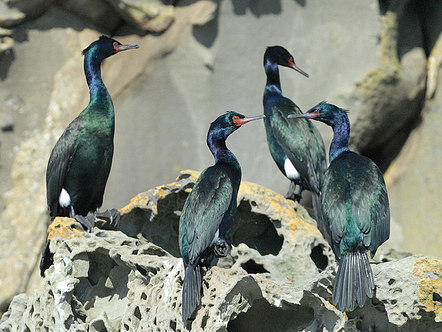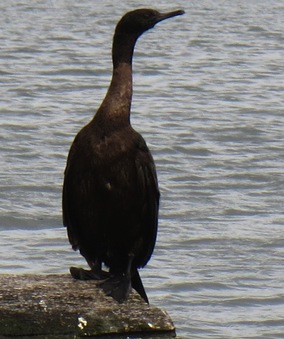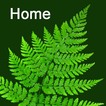Pelagic cormorant • Phalacrocorax pelagicus
|
Left: adult pelagic cormorants photographed by Mike Yip. Right: juvenile pelagic cormorant seen in Pruth Bay off Calvert Island. Photo by Christina Meschkat.
|
Identification
Cormorants are large waterbirds found along the coast. They are commonly seen flying, swimming, and standing on logs and posts. They have elongate bodies with legs set far back close to the tail, as well as long necks and long, straight bills with hooked ends. The pelagic cormorant is the smallest of the cormorants along the Pacific coast, and is characterized by its slender bill and neck. Juvenile birds are an overall dull brown colour with dark faces; once they mature their adult plumage is glossy with green and purple iridescent patches. Adults develop a white rump patch and two head crests during the summer breeding season; these showy additions disappear during the non-breeding months. The pelagic cormorant makes croaking and growling noises which are most commonly heard at nesting sites.
Habitat & Range
The pelagic cormorant is a year-round resident along the Central Coast. It is often found in bays, inlets, and outer coastal areas, such as near shore waters less than 100 m deep. It nests alone or in small groups on cliff edges on islands and along other narrow ledges on the coast, as well as in sea caves.
Find more information at the British Columbia Breeding Bird Atlas here.
Similar Species
Brandt’s cormorant (Phalacrocorax penicillatus) is similar in appearance but is distinguished by having a thicker bill and neck. Juveniles have a pale beige throat patch and breast on a dull brown body. During the breeding season adult Brandt’s cormorants have bright blue throat patches and they lack a white rump. The double-crested cormorant (Phalacrocorax auritus) can occur along the Central Coast during the winter but are less common. A good ID characteristic for this species is the orange throats and lores (the skin between the eye and nostril) found on both adults and juveniles throughout the year.
Intriguing Info
Pelagic cormorants incorporate their own guano during nest building on ledges and crevices to ensure a solid platform. They have less preen oil than most birds, which allows them to be faster under water, but it also means they can get soaked while swimming. Because of this, cormorants are often observed standing with their wings spread out in order to dry their feathers.
Cormorants are large waterbirds found along the coast. They are commonly seen flying, swimming, and standing on logs and posts. They have elongate bodies with legs set far back close to the tail, as well as long necks and long, straight bills with hooked ends. The pelagic cormorant is the smallest of the cormorants along the Pacific coast, and is characterized by its slender bill and neck. Juvenile birds are an overall dull brown colour with dark faces; once they mature their adult plumage is glossy with green and purple iridescent patches. Adults develop a white rump patch and two head crests during the summer breeding season; these showy additions disappear during the non-breeding months. The pelagic cormorant makes croaking and growling noises which are most commonly heard at nesting sites.
Habitat & Range
The pelagic cormorant is a year-round resident along the Central Coast. It is often found in bays, inlets, and outer coastal areas, such as near shore waters less than 100 m deep. It nests alone or in small groups on cliff edges on islands and along other narrow ledges on the coast, as well as in sea caves.
Find more information at the British Columbia Breeding Bird Atlas here.
Similar Species
Brandt’s cormorant (Phalacrocorax penicillatus) is similar in appearance but is distinguished by having a thicker bill and neck. Juveniles have a pale beige throat patch and breast on a dull brown body. During the breeding season adult Brandt’s cormorants have bright blue throat patches and they lack a white rump. The double-crested cormorant (Phalacrocorax auritus) can occur along the Central Coast during the winter but are less common. A good ID characteristic for this species is the orange throats and lores (the skin between the eye and nostril) found on both adults and juveniles throughout the year.
Intriguing Info
Pelagic cormorants incorporate their own guano during nest building on ledges and crevices to ensure a solid platform. They have less preen oil than most birds, which allows them to be faster under water, but it also means they can get soaked while swimming. Because of this, cormorants are often observed standing with their wings spread out in order to dry their feathers.
References
B.C. Conservation Data Centre (2014). Species Summary: Phalacrocorax pelagicus. B.C. Minist. of Environment. Accessed Jun 25/6/2014.
Double-crested Cormorant (Phalacrocorax auritus). The Birds of North America Online (A. Poole, Ed.). Ithaca: Cornell Lab of Ornithology. Retrieved from the Birds of North America Online. Accessed 26/6/2014.
Pelagic Cormorant (Phalacrocorax pelagicus). The Birds of North America Online (A. Poole, Ed.). Ithaca: Cornell Lab of Ornithology. Retrieved from the Birds of North America Online. Accessed 26/6/2014.
Sibley, D. (2003). The Sibley Field Guide to Birds of Western North America. Random House of Canada Limited, Toronto, ON, Canada. Pp. 51-52.
Authors and editors of page
Christina Meschkat, Kelly Fretwell, and Brian Starzomski (2014).
B.C. Conservation Data Centre (2014). Species Summary: Phalacrocorax pelagicus. B.C. Minist. of Environment. Accessed Jun 25/6/2014.
Double-crested Cormorant (Phalacrocorax auritus). The Birds of North America Online (A. Poole, Ed.). Ithaca: Cornell Lab of Ornithology. Retrieved from the Birds of North America Online. Accessed 26/6/2014.
Pelagic Cormorant (Phalacrocorax pelagicus). The Birds of North America Online (A. Poole, Ed.). Ithaca: Cornell Lab of Ornithology. Retrieved from the Birds of North America Online. Accessed 26/6/2014.
Sibley, D. (2003). The Sibley Field Guide to Birds of Western North America. Random House of Canada Limited, Toronto, ON, Canada. Pp. 51-52.
Authors and editors of page
Christina Meschkat, Kelly Fretwell, and Brian Starzomski (2014).





